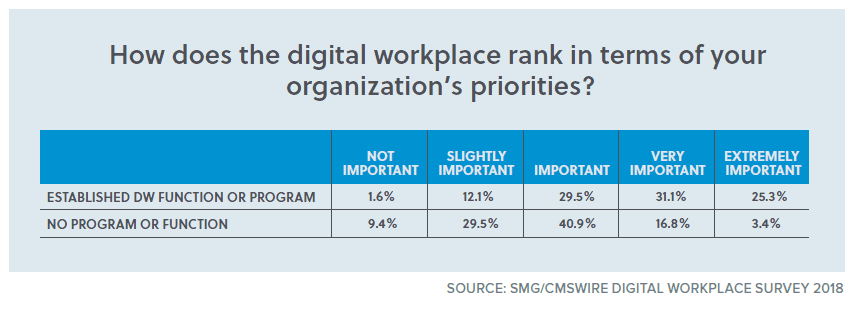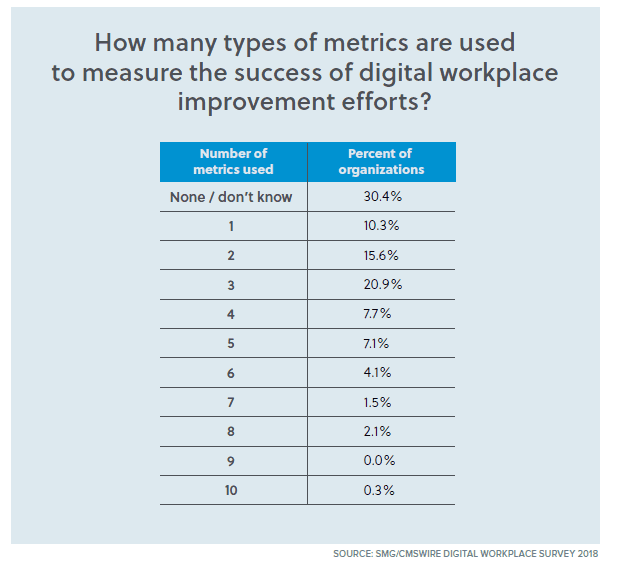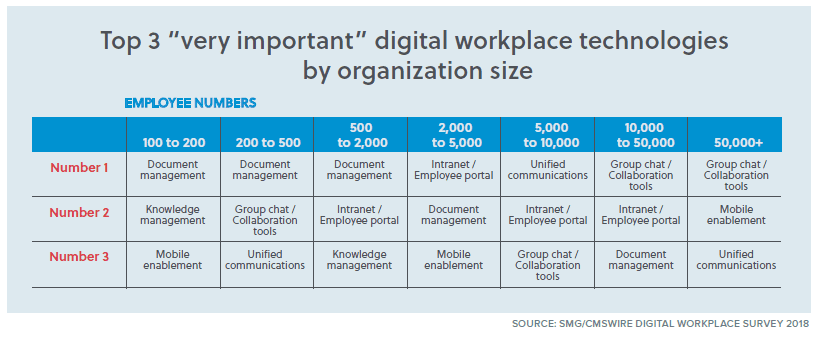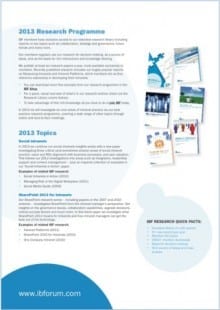What exactly is the state of the digital workplace?
The digital workplace concept and terminology has been picking up interest and momentum over the past year or so, and at the recent Digital Workplace Experience conference, it was obvious how well under way some organizations now are on their digital workplace journeys. Not only did we enjoy some excellent presentations from thought leaders and early adopters, but there were hundreds of attendees, many of whom had their own fascinating stories of digital workplace progress.
At the same time, however, it seems that many other organizations still have a very long way to go when it comes to building a compelling digital workplace experience. For example, anecdotally, we know that many organizations struggle with search and that many field, factory and retail workers still have inadequate access to digital services. It seems that for every exciting new experiment with chatbots or successful integration with ServiceNow, there are even more teams still struggling with intranet basics.
So, what exactly is the current state of the digital workplace? Along with our partners from CMSWire, we decided to carry out some research into where organizations are on their digital workplace journeys, and what their successes and challenges are. The results, gathered from over 450 executives, are contained in the 2018 edition of The State of the Digital Workplace, a free report available to download now. While, overall, the results didn’t necessarily surprise us, there were some fascinating insights. Here are five things from the report which particularly caught our eye!
1. The digital workplace is a priority, not a fad
With new trends and concepts, there is always the suspicion that they are riding on a certain novelty factor. However, the digital workplace concept is mature enough now not to be considered a fad and is actually a key priority for many organizations.

Nearly three quarters of respondents to the survey identified the digital workplace as “important”, “very important” or “extremely important”, numbers which are consistent with results from the 2017 survey. The survey results also indicate that a higher proportion of organizations which regard the digital workplace as a priority have now invested in a formal digital workplace programme or function, showing that some organizations have gone beyond the “planning” to the “implementation” phase in building a focused digital workplace for employees.
2. But overall the digital workplace is not mature
Collectively, however, the average digital workplace is still not mature. Despite all the talk of digital transformation or the rapid take-up of Office 365, only 16% of respondents claimed their digital workplace was mature; 46% regarded their digital workplace as in the early stages.
The survey also threw some light on various reasons for this lack of maturity, with companies identifying their key challenges. Perhaps unsurprisingly, strategy and governance areas, such as a lack of consensus among functions and not having the backing of senior leaders, appear to be behind some of the issues teams face, with the top three challenges identified as:
- budget constraints (34.8%)
- competing initiatives or departments (28%)
- siloed systems and data (26.8%).
3. Big data and analytics are priorities right now
Big data, data visualization and the power of data-driven decision-making have been themes in the digital workplace space for a long time now, but generally organizations have been slow to implement initiatives. However, we were excited to see that “Big data (advanced analytics and decision support)” was identified as the second most important digital workplace priority, just after “Culture and change”.
Meanwhile, a more “conventional” challenge for digital workplace teams, “Intranet effectiveness”, went from being the joint most popular priority in 2017 to the twelfth most important in 2018. This hints at a shift in thinking among digital workplace teams to evolve their thinking and finally harness the power of data for strategic and competitive advantage. We’ll be excited to see how this priority manifests itself in new projects and initiatives.
4. Not enough teams are measuring their digital workplace effectively
Anecdotally, we know there aren’t that many digital workplace teams successfully implementing measurement strategies and frameworks to manage, improve and track progress in the digital workplace. This is partly because measuring the digital workplace is still quite a nascent practice, but also perhaps because measurement isn’t necessarily a strength for intranet teams.
Responses to the State of the Digital Workplace Survey confirmed our suspicion that many teams are using very few metrics (e.g. two or three) to measure the digital workplace. However, an intriguing insight was that those teams who regarded themselves as having higher performing digital workplaces were also using more metrics. There’s an inference that can potentially be drawn here, which suggests that actively using a range of metrics can help you to improve your digital workplace – an insight we suspect to be true.

5. Traditional technologies are still at the core of the digital workplace
In the survey, organizations were asked about the relative importance of various digital workplace technologies. It was not surprising that the five top answers, based on the number of replies who declared a particular technology to be “very important”, comprised the more traditional areas, e.g. document management, group chat and collaboration tools, the intranet and unified communications.

More disruptive technologies, such as AI and automation, integrated task centres and microservices (all arguably up-and-coming elements of the digital workplace), appeared in the bottom five answers. This balance of answers is definitely a reflection of digital workplace maturity and it may be that over the next two years AI and microservices will start to creep up the list. We’ll find out in the 2019 survey!
Download the 2018 State of the Digital Workplace report
There’s a whole load of other interesting insights and nuggets of knowledge in the survey, and it’s definitely worth downloading (it’s free as well!). And, if you’re interested in finding more about the state of the digital workplace, stay tuned for more observations via this blog, through DWG research, as well an exciting “Digital Workplace Barometer” report (coming soon), which will take a deeper dive into some of the issues digital workplace teams face in 2018 and 2019!
Research and resources
- FREE EXECUTIVE SUMMARY: Measuring the digital workplace: The power of metrics in the connected workplace
- FREE REPORT: Digital Workplace 2030: Preparing now for the digital worlds of work to come
- PODCAST: Digital Workplace Impact – Your workplace is watching you!
TAKE THE NEXT STEP
Categorised in: Digital workplace, Digital workplace strategy


